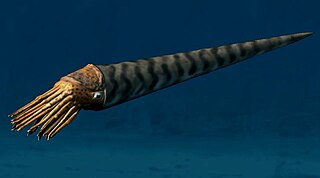
Nautiloids are a group of marine cephalopods (Mollusca) which originated in the Late Cambrian and are represented today by the living Nautilus and Allonautilus. Fossil nautiloids are diverse and speciose, with over 2,500 recorded species. They flourished during the early Paleozoic era, when they constituted the main predatory animals. Early in their evolution, nautiloids developed an extraordinary diversity of shell shapes, including coiled morphologies and giant straight-shelled forms (orthocones). Only a handful of rare coiled species, the nautiluses, survive to the present day.

Orthoceratidae is an extinct family of actively mobile carnivorous cephalopods, subclass Nautiloidea, that lived in what would be North America, Europe, Asia, Africa, and Australia from the Ordovician through Triassic from 490—203.7 mya, existing for approximately 286.4 million years.
The Ellesmerocerida is an order of primitive cephalopods belonging to the subclass Nautiloidea with a widespread distribution that lived during the Late Cambrian and Ordovician.

Goniatitina is one of two suborders included in the order Goniatitida; extinct Paleozoic ammonoid cephalopods only distantly related to the Nautiloidea.

The Oncocerida comprise a diverse group of generally small nautiloid cephalopods known from the Middle Ordovician to the Mississippian, in which the connecting rings are thin and siphuncle segments are variably expanded. At present the order consists of some 16 families, a few of which, such as the Oncoceratidae, Brevicoceratidae, and Acleistoceratidae contain a fair number of genera each while others like the Trimeroceratidae and Archiacoceratidae are represented by only two or three.

The Acleistoceratidae is a family of oncocerids that contains genera characterized by depressed exogastric brevicones and cyrtocones that range from the Middle Silurian to the Middle Devonian. The siphuncle is broadly expanded, and in some actinosiphonate.
The Brevicoceratidae is a family of oncocerids that contains genera characterized by exogastric gyrocones, brevicones, and torticones. that tend to develop vestigial actinosiphonate deposits and subtriangular transverse sections. The Brevicoceratidae are derived from Oonoceras (Oncoceratidae) and range from the mid-Silurian to the Upper Devonian.
Curtoceras is a genus in the tarphycerid family Trocholitidae found widespread in the late Early and Middle Ordovician of North America and northern Europe. Curtoceras has a shell that is gradually expanded, with half the fully mature body chamber divergent from the preceding volution. Whorl sections are near equidimentional with the inner margin (dosum) moderately impressed. The surface may be smooth or weakly ribbed. The siphuncle is ventral in the initial chamber and becomes dorsal after one volution. With the exception of the dorsal siphuncle, Curtoceras is somewhat similar to the tarphyceratid Campbelloceras
Spyroceras is a genus of pseudorthocerids from the Devonian of North America and Europe, defined by Alpheus Hyatt in 1884. Pseudorthocerids are a kind of orthocertaoid, a taxonomic group within the Nautiloidea. Specifically Spyroceras belongs to the pseudorthocerid family, Spyroceratidae.
Baltoceratidae is an extinct family of orthoconic cephalopods belonging to the subclass Nautiloidea endemic to what would be Asia, Australia, Europe, North America, and South America during the Ordovician living from about 480–460 mya, existing for approximately 20 million years.

Orthoceratoidea is a major subclass of nautiloid cephalopods. Members of this subclass usually have orthoconic (straight) to slightly cyrtoconic (curved) shells, and central to subcentral siphuncles which may bear internal deposits. Orthoceratoids are also characterized by dorsomyarian muscle scars, extensive cameral deposits, and calciosiphonate connecting rings with a porous and calcitic inner layer.
Jovellaniidae was established as a family within the Oncocerida to include genera characterized by longiconic orthocones and cyrtocones with a subtriangular to depressed cross-section in which the ventral (siphuncular) side is typically angular or more acutely rounded than the dorsal (antisiphuncular) side, and in which the siphuncle is generally large, ventral, and with lamellar actinosiphonate deposits
Hemiphragmoceratidae is a family of endogastrically brevconic oncocerids characterized by elaborately visored apertures in which the hyponomic sinus in mature specimens is on a spout-like process and there may be lateral and dorsal salients.. Shells are compressed with the apical portion curved and the anterior straight. Siphucles are nummuloideal with expanded spheroidal segments and continuously actinosiphonate interiors.
Syringonautilidae is a family of Nautiloidea from the middle to late Triassic. Syringonautilidae comprise the last of the Trigonoceratoidea and are the source for the Nautilaceae which continued the Nautiloidea through the Mesozoic and into the Cenozoic right down to the recent. Syringonautilidae is a strictly Triassic family, derived early in the Triassic from the Grypoceratidae.
The Valcouroceratidae is a family within the Oncocerida, nautiloid cephalopods from the middle and upper Ordovician, established by Rousseau Flower in 1945.
The Nautilitoidea is a superorder within the subclass Nautiloidea, comprising the phylogenetically related Nautilida, Oncocerida, and Tarphycerida.
Sactorthceras is an orthoceratoid genus known from the Middle Ordovician of eastern North America (NY), Norway and Korea and is the type genus of the Sactorthoceratidae.

Ellesmeroceras is the type genus for the Ellesmeroceratidae, a family of primitive nautiloid cephalopods, that is characterized by its small, generally compressed, gradually expanded, orthoconic shell, found in Lower Ordovician marine sediments. The septa are close spaced and the siphuncle is ventral, about 0.2 the diameter of the shell. Septal necks are typically orthochoanitic but may slant inwardly (loxochoanitic) or reach halfway to the previous septum (hemichoanitic). Connecting rings are thick. As common for the Ellesmerocerida, Ellesmeroceras has diaphragms within the siphuncle tube.

Geisonoceras is an extinct orthocerid genus named by Hyatt, 1884, and type for the Geisonoceratidae established by Zhuravleva in 1959.
Kiaeroceras is a slender, nearly stright shelled, cyrogomphoceratid (Nautiloidea-Discosorida) from the Upper Ordovician of northern Europe. The cross section of the shell is compressed, height greater than width. The body chamber is slightly contracted so as to narrow toward the aperture, which in some is slightly flared. The venter, narrowly rounded. The siphuncle is close to the venter, septal necks short, connecting rings thick, bullettes prominent.







